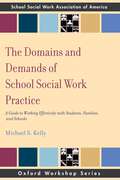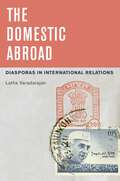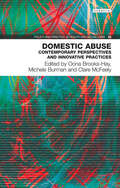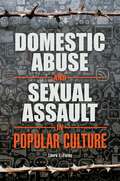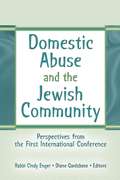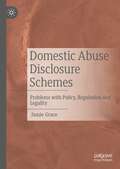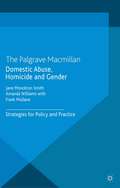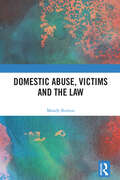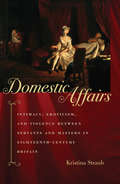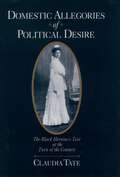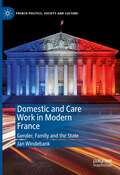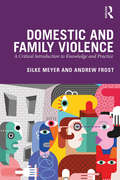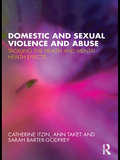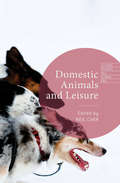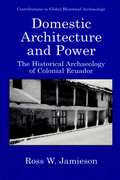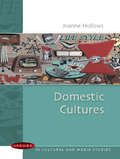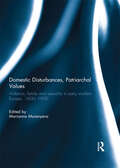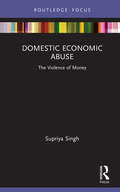- Table View
- List View
The Domains and Demands of School Social Work Practice: A Guide to Working Effectively with Students, Families and Schools (SSWAA Workshop Series)
by Michael S KellySchool social work enters its second century as a profession still conflicted about its central mission. Are school social workers meant to be "in-house" clinicians providing services to kids in need, or are they meant to be involved in program development to enhance the social and emotional learning of all students in a school? How much time should they devote to serving whole families, or consulting with teachers? Whatever school social workers claim to do in their schools, it's clear that they are going to have to prove that they are effective doing it. The demands of federal legislation like No Child Left Behind and state requirements for certification are making it increasingly necessary that school social workers demonstrate that they are highly qualified school-based mental health and social service professionals who can demonstrate outcomes that impact school "bottom line" issues like student achievement, attendance, and behavior. Rather than recoil from this pressure, school social workers can utilize the skills of evidence based practice (EBP) to help them enhance both their effectiveness and their knowledge of interventions that work to help students, teachers, parents, and staff in school contexts. A succinct SSWAA Workshop volume, The Domains and Demands of School Social Work Practice demonstrates how EBP can be integrated into school social worker's daily practice, advancing the debate about where social workers can and should intervene, and how to do so effectively. Highlighting primary clinical issues, family problems, and school-wide needs faced by school social workers, it helps practitioners make the best use of evidence to be flexible, effective advocates at all levels of practice.
The Domestic Abroad: Diasporas in International Relations
by Latha VaradarajanIn the past few decades, and across disparate geographical contexts, states have adopted policies and initiatives aimed at institutionalizing relationships with "their" diasporas. These practices, which range from creating new ministries to granting dual citizenship, are aimed at integrating diasporas as part of a larger "global" nation that is connected to, and has claims on the institutional structures of the home state. Although links, both formal and informal, between diasporas and their presumptive homelands have existed in the past, the recent developments constitute a far more widespread and qualitatively different phenomenon. In this book, Latha Varadarajan theorizes this novel and largely overlooked trend by introducing the concept of the "domestic abroad." Varadarajan demonstrates that the remapping of the imagined boundaries of the nation, the visible surface of the phenomenon, is intrinsically connected to the political-economic transformation of the state that is typically characterized as "neoliberalism." The domestic abroad must therefore be understood as the product of two simultaneous, on-going processes: the diasporic re-imagining of the nation and the neoliberal restructuring of the state. The argument unfolds through a historically nuanced study of the production of the domestic abroad in India. The book traces the complex history and explains the political logic of the remarkable transition from the Indian state's guarded indifference toward its diaspora in the period after independence, to its current celebrations of the "global Indian nation." In doing so, The Domestic Abroad reveals the manner in which the boundaries of the nation and the extent of the authority of the state, in India and elsewhere, are dynamically shaped by the development of capitalist social relations on both global and national scales.
The Domestic Abroad: Diasporas in International Relations
by Latha VaradarajanIn the past few decades, and across disparate geographical contexts, states have adopted policies and initiatives aimed at institutionalizing relationships with "their" diasporas. These practices, which range from creating new ministries to granting dual citizenship, are aimed at integrating diasporas as part of a larger "global" nation that is connected to, and has claims on the institutional structures of the home state. Although links, both formal and informal, between diasporas and their presumptive homelands have existed in the past, the recent developments constitute a far more widespread and qualitatively different phenomenon. In this book, Latha Varadarajan theorizes this novel and largely overlooked trend by introducing the concept of the "domestic abroad." Varadarajan demonstrates that the remapping of the imagined boundaries of the nation, the visible surface of the phenomenon, is intrinsically connected to the political-economic transformation of the state that is typically characterized as "neoliberalism." The domestic abroad must therefore be understood as the product of two simultaneous, on-going processes: the diasporic re-imagining of the nation and the neoliberal restructuring of the state. The argument unfolds through a historically nuanced study of the production of the domestic abroad in India. The book traces the complex history and explains the political logic of the remarkable transition from the Indian state's guarded indifference toward its diaspora in the period after independence, to its current celebrations of the "global Indian nation." In doing so, The Domestic Abroad reveals the manner in which the boundaries of the nation and the extent of the authority of the state, in India and elsewhere, are dynamically shaped by the development of capitalist social relations on both global and national scales.
Domestic Abuse: Contemporary Perspectives and Innovative Practices (Policy and Practice in Health and Social Care)
by Oona Brooks-Hay Michele BurmanDomestic abuse is a persistent global health and social problem with far reaching consequences at both an individual and a societal level. Internationally, significant progress has been made in addressing domestic abuse and responses to the problem have evolved rapidly in recent years. However, considerable challenges still exist across a range of jurisdictions in terms of how to define, conceptualise, prevent and respond to domestic abuse.The Scottish Parliament has developed a distinctive approach to defining and addressing domestic abuse, informed by a history of feminist activism, and has adopted a gendered definition of domestic abuse not shared in other parts of the UK. This approach explicitly positions domestic abuse as both a cause and consequence of gender inequality. In Scotland, domestic abuse is therefore addressed within an equalities framework. Whilst this approach is underpinned by international treaties shared by other countries, Scotland’s approach is considered to be particularly progressive.By illustrating contemporary research and practice in Scotland, and situating this evidence within an international context, this volume provides a valuable source of national and international knowledge for those working and studying across a broad range of sectors, including health, education, housing, social work, criminal justice, law and politics. A feminist theoretical perspective, which recognises domestic abuse as a function of gendered inequalities, is adopted as a framework for understanding the research evidence and practices discussed throughout the book.
Domestic Abuse and Sexual Assault in Popular Culture (Crime in Popular Culture)
by Laura L. FinleyUsing historical and current examples from film, television, literature, advertisements, and music, this book reveals the ways that rape and abuse are typically presented—and misrepresented—and evaluates the impact of these depictions on consumers.Incidences of domestic abuse and sexual assault aren't only commonplace nationwide and the source of a shockingly large number of serious injuries and deaths; they're also problems that are often subject to myths and misleading depictions in popular culture and media. The author of this important book seeks to shed light on the situation by examining the specific issues related to domestic violence and sexual assault, from the scope and extent of the problem to victim and offender characteristics, and from common misconceptions to societal, cultural, and judicial responses and prevention efforts.Each chapter discusses movies, music, literature, and other forms of popular culture that address issues of domestic abuse and sexual assault, identifying both accurate depictions and problematic examples. The final section of the book addresses how our culture responds to and attempts to prevent domestic abuse and sexual assault, covering depictions of police response to these kinds of crimes in popular culture, how the justice system handles these cases, and individual and community efforts to curb domestic abuse and sexual assault. A compendium of films, documentaries, popular books, and song lyrics featuring domestic abuse and sexual assault enables readers to easily investigate the subject further.
Domestic Abuse and Sexual Assault in Popular Culture (Crime in Popular Culture)
by Laura L. FinleyUsing historical and current examples from film, television, literature, advertisements, and music, this book reveals the ways that rape and abuse are typically presented—and misrepresented—and evaluates the impact of these depictions on consumers.Incidences of domestic abuse and sexual assault aren't only commonplace nationwide and the source of a shockingly large number of serious injuries and deaths; they're also problems that are often subject to myths and misleading depictions in popular culture and media. The author of this important book seeks to shed light on the situation by examining the specific issues related to domestic violence and sexual assault, from the scope and extent of the problem to victim and offender characteristics, and from common misconceptions to societal, cultural, and judicial responses and prevention efforts.Each chapter discusses movies, music, literature, and other forms of popular culture that address issues of domestic abuse and sexual assault, identifying both accurate depictions and problematic examples. The final section of the book addresses how our culture responds to and attempts to prevent domestic abuse and sexual assault, covering depictions of police response to these kinds of crimes in popular culture, how the justice system handles these cases, and individual and community efforts to curb domestic abuse and sexual assault. A compendium of films, documentaries, popular books, and song lyrics featuring domestic abuse and sexual assault enables readers to easily investigate the subject further.
Domestic Abuse and the Jewish Community: Perspectives from the First International Conference
by Diane GardsbaneLearn ways to address domestic and sexual abuse in your communityBreaking the cycle of domestic violence and abuse poses unique problems for the Jewish community, owing to the internal divisions of politics, religious practice, and culture. However, creating strategies to work together based upon the shared values of Judaism can strip away those differences. Domestic Abuse and the Jewish Community: Perspectives from the First International Conference brings together an outstanding and diverse selection of notable presentations from the First International Conference on Domestic Abuse in the Jewish Community held in July 2003 in Baltimore, Maryland. The conference, entitled "Pursuing Truth, Justice, and Righteousness: A Call to Action," brought to the forefront the disturbing, many times hidden issue of domestic abuse within the Jewish community. Respected scholars, clergy, social service professionals, and survivors provide insightful presentations that lay an essential foundation for the building of a collaborative global Jewish movement to respond to this sensitive issue.Domestic Abuse and the Jewish Community: Perspectives from the First International Conference marks the start of a quiet revolution aimed at ending domestic abuse in various Jewish communities by revealing the many facets of the problem while offering ways to address them. Sexual and domestic abuse issues in the Jewish communities of the US, Israel, South Africa and the UK are illuminated and described, and practical strategies are discussed, keeping in mind the common goals within the varied communities. Jewish religious law is reviewed, along with an analysis of Maimomides&’ response to domestic abuse, and a vision is offered to respond to child sexual abuse.Domestic Abuse and the Jewish Community: Perspectives from the First International Conference is separated into five categories of presentations: Illuminating the Issue; Healing and Wholeness; Promising Practices; Creating Change; and Breaking the Cycle, each section progressing logically to present a unified discussion of the issues. The book discusses: helping religious women escape domestic abuse the Jewish tradition and the treatment of battered women the widespread claim that Maimonedes condoned wife-battering the spiritual movement called neohasidism the issues of reconciliation between survivors and former perpetrators the Ayelet Program-a project which provides long-term mentoring to past victims starting a new life organizing the community to address domestic violence in immigrant populations the response to domestic violence in the South African Jewish community services for victims in Israel child sexual abuse and incest Domestic Abuse and the Jewish Community: Perspectives from the First International Conference is informative, eye-opening reading for social workers, clergy, direct service providers for survivors of domestic/sexual abuse, directors/staff of Jewish Family Service agencies, Jewish Federations, Jewish women&’s organizations, and Jewish foundations.
Domestic Abuse and the Jewish Community: Perspectives from the First International Conference
by Diane GardsbaneLearn ways to address domestic and sexual abuse in your communityBreaking the cycle of domestic violence and abuse poses unique problems for the Jewish community, owing to the internal divisions of politics, religious practice, and culture. However, creating strategies to work together based upon the shared values of Judaism can strip away those differences. Domestic Abuse and the Jewish Community: Perspectives from the First International Conference brings together an outstanding and diverse selection of notable presentations from the First International Conference on Domestic Abuse in the Jewish Community held in July 2003 in Baltimore, Maryland. The conference, entitled "Pursuing Truth, Justice, and Righteousness: A Call to Action," brought to the forefront the disturbing, many times hidden issue of domestic abuse within the Jewish community. Respected scholars, clergy, social service professionals, and survivors provide insightful presentations that lay an essential foundation for the building of a collaborative global Jewish movement to respond to this sensitive issue.Domestic Abuse and the Jewish Community: Perspectives from the First International Conference marks the start of a quiet revolution aimed at ending domestic abuse in various Jewish communities by revealing the many facets of the problem while offering ways to address them. Sexual and domestic abuse issues in the Jewish communities of the US, Israel, South Africa and the UK are illuminated and described, and practical strategies are discussed, keeping in mind the common goals within the varied communities. Jewish religious law is reviewed, along with an analysis of Maimomides&’ response to domestic abuse, and a vision is offered to respond to child sexual abuse.Domestic Abuse and the Jewish Community: Perspectives from the First International Conference is separated into five categories of presentations: Illuminating the Issue; Healing and Wholeness; Promising Practices; Creating Change; and Breaking the Cycle, each section progressing logically to present a unified discussion of the issues. The book discusses: helping religious women escape domestic abuse the Jewish tradition and the treatment of battered women the widespread claim that Maimonedes condoned wife-battering the spiritual movement called neohasidism the issues of reconciliation between survivors and former perpetrators the Ayelet Program-a project which provides long-term mentoring to past victims starting a new life organizing the community to address domestic violence in immigrant populations the response to domestic violence in the South African Jewish community services for victims in Israel child sexual abuse and incest Domestic Abuse and the Jewish Community: Perspectives from the First International Conference is informative, eye-opening reading for social workers, clergy, direct service providers for survivors of domestic/sexual abuse, directors/staff of Jewish Family Service agencies, Jewish Federations, Jewish women&’s organizations, and Jewish foundations.
Domestic Abuse Disclosure Schemes: Problems with Policy, Regulation and Legality
by Jamie GraceThis book draws on empirical work to examine the debates surrounding domestic violence disclosure schemes (also known as Clare's Law), focussing on England and Wales with comparisons to similar jurisdictions. Clare's Law allows any member of the public the right to ask the police if their partner may pose a risk to them. This book sets out a coherent methodology for analysing these schemes which are growing in popularity. It discusses their pros and cons and the challenges with operating and regulating them. It ultimately seeks to examine whether the disclosure of information concerning the criminal history of one person to that person's intimate partner will ultimately increase the likelihood of keeping their partner safe. It speaks to academics working in the domestic violence / regulation/ criminal justice/ criminology fields as well as by policy makers in front line services and government agencies.
Domestic Abuse, Homicide and Gender: Strategies for Policy and Practice
by J. Monckton-Smith A. Williams F. MullaneBased on research with frontline professionals and domestic abuse and homicide victims, this book argues for a re-conceptualisation of the female victim to enhance safety management and encourage a deeper understanding of the emotional dynamics and social structures which perpetuate violence.
Domestic Abuse, Victims and the Law
by Mandy BurtonThe gap between what the law and legal processes deliver for victims of domestic abuse and what they actually need has, in some instances, arguably widened. This book provides the reader with a thorough understanding of the remedies available to victims in the civil, family and criminal law. It contends that expectations of the legal remedies have increased as the number and scope of remedies has proliferated. It further examines how legal responses to domestic abuse have evolved over the past decade and explores how the victim’s rights narrative and associated litigation, which has become prevalent in legal discourse and criminal justice reforms, has shifted expectations and impacted domestic abuse policy and law. The book presents a valuable addition to the literature in drawing on a discourse familiar to those with an interest in human rights, demonstrating its impact on a substantive area of law of great significance to both family and criminal lawyers and anyone with an interest in domestic abuse and legal responses.
Domestic Affairs: Intimacy, Eroticism, and Violence between Servants and Masters in Eighteenth-Century Britain
by Kristina StraubFrom Daniel Defoe’s Family Instructor to William Godwin’s political novel Caleb Williams, literature written for and about servants tells a hitherto untold story about the development of sexual and gender ideologies in the early modern period. This original study explores the complicated relationships between domestic servants and their masters through close readings of such literary and nonliterary eighteenth-century texts. The early modern family was not biologically defined. It included domestic servants who often had strong emotional and intimate ties to their masters and mistresses. Kristina Straub argues that many modern assumptions about sexuality and gender identity have their roots in these affective relationships of the eighteenth-century family. By analyzing a range of popular and literary works—from plays and novels to newspapers and conduct manuals—Straub uncovers the economic, social, and erotic dynamics that influenced the development of these modern identities and ideologies.Highlighting themes important in eighteenth-century studies—gender and sexuality; class, labor, and markets; family relationships; and violence—Straub explores how the common aspects of human experience often intersected within the domestic sphere of master and servant. In examining the interpersonal relationships between the different classes, she offers new ways in which to understand sexuality and gender in the eighteenth century.
Domestic Allegories Of Political Desire: The Black Heroine's Text At The Turn Of The Century
by Claudia TateWhy did African-American women novelists use idealized stories of bourgeois courtship and marriage to mount arguments on social reform during the last decade of the nineteenth century, during a time when resurgent racism conditioned the lives of all black Americans? Such stories now seem like apolitical fantasies to contemporary readers. This is the question at the center of Tate's examination of the novels of Pauline Hopkins, Emma Kelley, Amelia Johnson, Katherine Tillman, and Frances Harper.Domestic Allegories of Political Desireis more than a literary study; it is also a social and intellectual history--a cultural critique of a period that historian Rayford W. Logan called "the Dark Ages of recent American history." Against a rich contextual framework, extending from abolitionist protest to the Black Aesthetic, Tate argues that the idealized marriage plot in these novels does not merely depict the heroine's happiness and economic prosperity. More importantly, that plot encodes a resonant cultural narrative--a domestic allegory--about the political ambitions of an emancipated people. Once this domestic allegory of political desire is unmasked in these novels, it can be seen as a significant discourse of the post-Reconstruction era for representing African-Americans' collective dreams about freedom and for reconstructing those contested dreams into consummations of civil liberty.
Domestic and Care Work in Modern France: Gender, Family and the State (French Politics, Society and Culture)
by Jan WindebankThis book explores the organization and divisions of labour of domestic and care work in modern France and in so doing, reveals some of the drivers of and obstacles to change in the relationship between gender, the family, and the French state. The book finds that both the policies and social norms that structure how domestic and care work is carried out and by whom in contemporary France have been influenced by historical legacies dating back to the Revolution such as French Republicanism and pronatalism, and more recent political currents such as the self-management movement and materialist feminism. Chapter 1 sets out the analytical framework for the book, while Chapter 2 explores the historical legacies that help shape contemporary domestic and care work in France. Chapters 3, 4, and 5 focus on the specific activities of parental and childcare work, long-term care for adults, and domestic work in the contemporary period. Chapter 6 discusses the effects of the COVID-19 restrictions on domestic and care work, and Chapter 7 concludes the discussion.
Domestic and Family Violence: A Critical Introduction to Knowledge and Practice
by Silke Meyer Andrew FrostDomestic and family violence (DFV) is an enduring social and public health issue of endemic proportions and global scale, with multiple and lasting consequences for those directly affected. This book tackles current debates in the field and addresses the social norms and settings that perpetuate this type of violence, along with implications for service delivery. The book offers a thorough introduction into the nature and extent of DFV in contemporary social contexts and serves as a foundation for informed practice. It provides a firm theoretical and empirical overview of core issues, covering the challenges and support needs experienced by those affected, along with the implications this raises for the range of relevant response services. The authors also offer insight into the predominantly gendered nature of DFV and its influence beyond the traditional couple context, across age, gender, sexual orientation, cultural background, and family relationships. Drawing on theoretical explanations, international research, and practice experience, they highlight examples of good practice and holistic responses, including primary, secondary, and tertiary prevention. Written in a clear and direct style, this book will appeal to students and scholars of criminology, sociology, and social work engaged in studies of domestic and family violence, violence against women, and intimate partner violence. It will be an invaluable resource for those designing, coordinating, and conducting service responses.
Domestic and Family Violence: A Critical Introduction to Knowledge and Practice
by Silke Meyer Andrew FrostDomestic and family violence (DFV) is an enduring social and public health issue of endemic proportions and global scale, with multiple and lasting consequences for those directly affected. This book tackles current debates in the field and addresses the social norms and settings that perpetuate this type of violence, along with implications for service delivery. The book offers a thorough introduction into the nature and extent of DFV in contemporary social contexts and serves as a foundation for informed practice. It provides a firm theoretical and empirical overview of core issues, covering the challenges and support needs experienced by those affected, along with the implications this raises for the range of relevant response services. The authors also offer insight into the predominantly gendered nature of DFV and its influence beyond the traditional couple context, across age, gender, sexual orientation, cultural background, and family relationships. Drawing on theoretical explanations, international research, and practice experience, they highlight examples of good practice and holistic responses, including primary, secondary, and tertiary prevention. Written in a clear and direct style, this book will appeal to students and scholars of criminology, sociology, and social work engaged in studies of domestic and family violence, violence against women, and intimate partner violence. It will be an invaluable resource for those designing, coordinating, and conducting service responses.
Domestic and Sexual Violence and Abuse: Tackling the Health and Mental Health Effects
by Catherine Itzin Ann Taket Sarah Barter-GodfreyDomestic violence, childhood sexual abuse, rape and sexual assault, and sexual exploitation through prostitution, pornography and trafficking can have many significant adverse impacts on a survivor’s health and wellbeing, in the short, medium and long-term. Taking a life-course approach, the book explores what is known about appropriate treatment responses to those who have experienced, and those who perpetrate, domestic and sexual violence and abuse. The book also examines key factors that are important in understanding how and why different groups experience heightened risks of domestic and sexual violence and abuse, namely: gender and sexuality; race and culture; disability; and abuse by professionals. Drawing together results from specially commissioned research, the views of experts by experience, experts by profession and the published research literature, the book argues that sufficient is already known to delineate an appropriate public health framework, encompassing primary, secondary and tertiary prevention, to successfully tackle the important public health issue represented by domestic and sexual violence and abuse. Domestic and Sexual Violence and Abuse equips health and social care professionals and services to identify and respond to the needs of affected individuals with a view to the prevention and early intervention.
Domestic and Sexual Violence and Abuse: Tackling the Health and Mental Health Effects
by Catherine Itzin Ann Taket Sarah Barter-GodfreyDomestic violence, childhood sexual abuse, rape and sexual assault, and sexual exploitation through prostitution, pornography and trafficking can have many significant adverse impacts on a survivor’s health and wellbeing, in the short, medium and long-term. Taking a life-course approach, the book explores what is known about appropriate treatment responses to those who have experienced, and those who perpetrate, domestic and sexual violence and abuse. The book also examines key factors that are important in understanding how and why different groups experience heightened risks of domestic and sexual violence and abuse, namely: gender and sexuality; race and culture; disability; and abuse by professionals. Drawing together results from specially commissioned research, the views of experts by experience, experts by profession and the published research literature, the book argues that sufficient is already known to delineate an appropriate public health framework, encompassing primary, secondary and tertiary prevention, to successfully tackle the important public health issue represented by domestic and sexual violence and abuse. Domestic and Sexual Violence and Abuse equips health and social care professionals and services to identify and respond to the needs of affected individuals with a view to the prevention and early intervention.
Domestic Animals and Leisure: Rights, Welfare, And Wellbeing (Leisure Studies in a Global Era)
by Neil CarrThis volume offers both an insight into the current state of research on domestic animals in leisure and a lens through which to begin to chart the future of research in this field. All of the contributions to the collection are underpinned by ongoing debates about human-animal relationships and the rights and welfare of the latter.
Domestic Architecture and Power: The Historical Archaeology of Colonial Ecuador (Contributions To Global Historical Archaeology)
by Ross W. JamiesonHistorical archaeology, one of the fastest growing of archaeology’s sub fields in North America, has developed more slowly in Central and p- ticularly South America. Happily, this circumstance is ending as a gr- ing number of recent projects are successfully integrating textual and material culture data in studies of the events and processes of the last 500 years. This interval and this region–often called Ibero-America–have been studied for a century or more by historians with traditional perspectives and emphases focusing on colonial elites and large-scale politico-economic events. Such inclinations fit well into world-system and other core-peri- ery models that have had a major impact on historical thought since the 1970s. Over the past 20 years or so, however, world-system models have come under fire from historians, anthropologists, and others, in part because the emphasis on global trends and the growth of capitalism - nies the importance of understanding variability in local histories and circumstances. Historians have increasingly turned their attention to lo cal, rural, and domestic contexts, thereby illuminating the great diversity of responses to colonial domination that were played out in the vast arena of the Americas. It is not coincidental that this is the intellectual climate in which historical archaeology is establishing itself in Central and South America.
Domestic Cultures (UK Higher Education OUP Humanities & Social Sciences Media, Film & Cultural Studies)
by Joanne HollowsAlthough ‘home’ is central to most people’s experience of everyday life, the meaning of home is often taken for granted. In this accessible and student-friendly introduction to domestic cultures, Joanne Hollows surveys current thinking and approaches to demonstrate why home is so central to our lives.Domestic Cultures examines which meanings and values have been associated with home and demonstrates how these have been transformed and reworked in different historical contexts. The book shows that while certain meanings of domestic culture are frequently produced ‘for us’, these can be negotiated and resisted through everyday home-making practices. She demonstrates how elements of domesticity have been dislocated and mobilized within public life.This wide-ranging text challenges a range of ideas about domestic culture. It examines how the meanings of domestic life are produced across a range of discourses and practices, from architecture, lifestyle media and advertising to home decoration, cooking and watching television. The book demonstrates how domestic cultures are not only linked to particular ideas about gendered identities, but how they are also differentiated by class, race and sexuality.Domestic Cultures is a key introductory text for media, sociology and cultural studies students.
Domestic Disturbances, Patriarchal Values: Violence, Family and Sexuality in Early Modern Europe, 1600-1900
by Marianna MuravyevaThis book offers an in-depth analysis of several national case studies on family violence between the sixteenth and nineteenth centuries, using court records as their main source. It raises important questions for research on early modern Europe: the notion of absolute power; sovereignty and its applicability to familial power; the problem of violence and the possibility of its usage for conflict resolution both in public and private spaces; and the interconnection of gender and violence against women, reconsidered in the context of modern state formation as a public sphere and family building as a private sphere. Contributors bring together detailed studies of domestic violence and spousal murder in Romania, England, and Russia, abduction and forced marriage in Poland, infanticide and violence against parents in Finland, and rape and violence against women in Germany. These case studies serve as the basis for a comparative analysis of forms, models, and patterns of violence within the family in the context of debates on political power, absolutism, and violence. They highlight changes towards unlimited violence by family patriarchs in European countries, in the context of the changing relationship between the state and its citizens. This book was originally published as a special issue of the Journal of the History of the Family.
Domestic Disturbances, Patriarchal Values: Violence, Family and Sexuality in Early Modern Europe, 1600-1900
by Marianna MuravyevaThis book offers an in-depth analysis of several national case studies on family violence between the sixteenth and nineteenth centuries, using court records as their main source. It raises important questions for research on early modern Europe: the notion of absolute power; sovereignty and its applicability to familial power; the problem of violence and the possibility of its usage for conflict resolution both in public and private spaces; and the interconnection of gender and violence against women, reconsidered in the context of modern state formation as a public sphere and family building as a private sphere. Contributors bring together detailed studies of domestic violence and spousal murder in Romania, England, and Russia, abduction and forced marriage in Poland, infanticide and violence against parents in Finland, and rape and violence against women in Germany. These case studies serve as the basis for a comparative analysis of forms, models, and patterns of violence within the family in the context of debates on political power, absolutism, and violence. They highlight changes towards unlimited violence by family patriarchs in European countries, in the context of the changing relationship between the state and its citizens. This book was originally published as a special issue of the Journal of the History of the Family.
Domestic Economic Abuse: The Violence of Money (Routledge Advances in Sociology)
by Supriya SinghSupriya Singh tells the stories of 12 Anglo-Celtic and Indian women in Australia who survived economic abuse. She describes the lived experience of coercive control underlying economic abuse across cultures. Each story shows how the woman was trapped and lost her freedom because her husband denied her money, appropriated her assets and sabotaged her ability to be in paid work. These stories are about silence, shame and embarrassment that this could happen despite professional and graduate education. Some of the women were the main earners in their household. Women spoke of being afraid, of trying to leave, of losing their sense of self. Many suffered physical and mental ill-health, not knowing what would trigger the violence. Some attempted suicide. None of the women fully realised they were suffering family violence through economic abuse, whilst it was happening to them. The stories of Anglo-Celtic and Indian women show economic abuse is not associated with a specific system of money management and control. It is when the morality of money is betrayed that control becomes coercive. Money as a medium of care then becomes a medium of abuse. The women’s stories demonstrate the importance of talking about money and relationships with future partners, across life stages and with their sons and daughters. The women saw this as an essential step for preventing and lessening economic abuse. A vital read for scholars of domestic abuse and family violence that will also be valuable for sociologists of money.
Domestic Economic Abuse: The Violence of Money (Routledge Advances in Sociology)
by Supriya SinghSupriya Singh tells the stories of 12 Anglo-Celtic and Indian women in Australia who survived economic abuse. She describes the lived experience of coercive control underlying economic abuse across cultures. Each story shows how the woman was trapped and lost her freedom because her husband denied her money, appropriated her assets and sabotaged her ability to be in paid work. These stories are about silence, shame and embarrassment that this could happen despite professional and graduate education. Some of the women were the main earners in their household. Women spoke of being afraid, of trying to leave, of losing their sense of self. Many suffered physical and mental ill-health, not knowing what would trigger the violence. Some attempted suicide. None of the women fully realised they were suffering family violence through economic abuse, whilst it was happening to them. The stories of Anglo-Celtic and Indian women show economic abuse is not associated with a specific system of money management and control. It is when the morality of money is betrayed that control becomes coercive. Money as a medium of care then becomes a medium of abuse. The women’s stories demonstrate the importance of talking about money and relationships with future partners, across life stages and with their sons and daughters. The women saw this as an essential step for preventing and lessening economic abuse. A vital read for scholars of domestic abuse and family violence that will also be valuable for sociologists of money.
